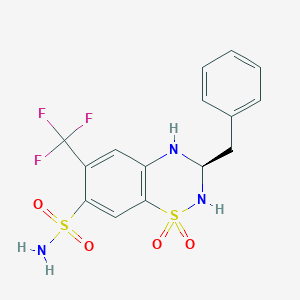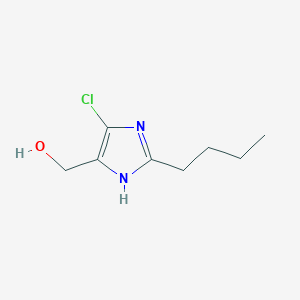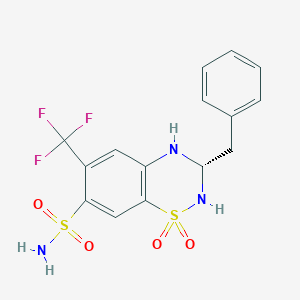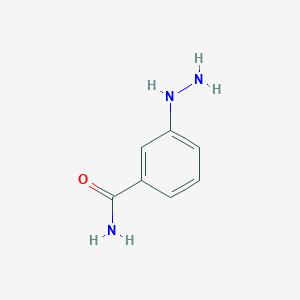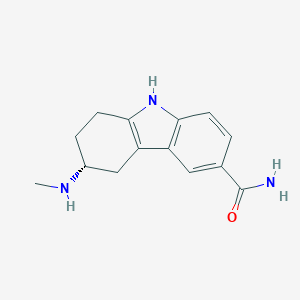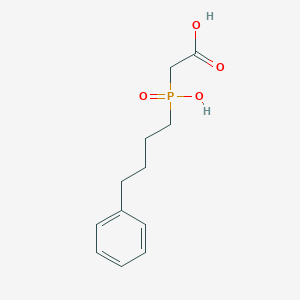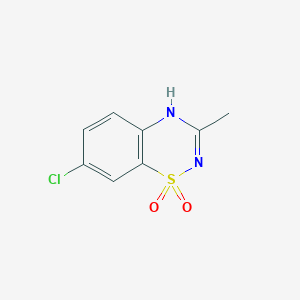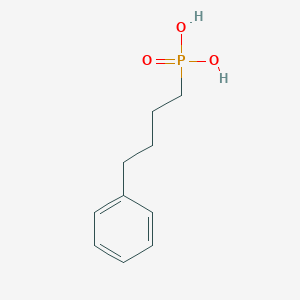
Abirateron
Übersicht
Beschreibung
Abiraterone is a potent antiandrogen used primarily in the treatment of metastatic castration-resistant prostate cancer and metastatic high-risk castration-sensitive prostate cancer . It is a selective inhibitor of the enzyme 17α-hydroxylase/C17,20-lyase (CYP17), which plays a crucial role in androgen biosynthesis . Abiraterone is often administered in the form of its prodrug, abiraterone acetate, to enhance its stability and absorption .
Wissenschaftliche Forschungsanwendungen
Abiraterone has a wide range of scientific research applications:
Chemistry: It is used as a model compound for studying steroidal enzyme inhibitors.
Biology: Abiraterone is employed in research on androgen biosynthesis and its inhibition.
Industry: Abiraterone acetate formulations are developed to improve bioavailability and patient compliance.
Wirkmechanismus
Target of Action
Abiraterone primarily targets the enzyme 17 α-hydroxylase/C17,20-lyase (CYP17) . This enzyme is expressed in testicular, adrenal, and prostatic tumor tissues and plays a crucial role in regulating androgen biosynthesis .
Mode of Action
Abiraterone is a potent, irreversible, and selective inhibitor of CYP17 . By inhibiting this enzyme, abiraterone suppresses the production of androgens, including testosterone, which are essential for the growth of prostate cancer cells . This leads to a decrease in tumor testosterone and dihydrotestosterone levels .
Biochemical Pathways
The inhibition of CYP17 by abiraterone affects the androgen synthesis pathway . Specifically, it suppresses the hydroxylation of pregnenolone and progesterone at C17, which limits the subsequent conversion of these hydroxylated metabolites to dehydroepiandrosterone (DHEA) and androstenedione . This results in decreased production of androgens, thereby slowing down the growth of prostate tumors .
Pharmacokinetics
Abiraterone has poor oral bioavailability and is susceptible to hydrolysis by esterases . To overcome this, abiraterone acetate, an orally bioavailable prodrug with enhanced stability and absorption, was developed . Once in the body, abiraterone acetate is converted to abiraterone . The maximum plasma concentration of abiraterone under fasting conditions is 27.02 ± 14.21 ng/mL, and its elimination half-life is between 12–24 hours . It is primarily excreted in feces (88%) and urine (5%) .
Result of Action
The inhibition of androgen production by abiraterone leads to a decrease in the growth of prostate cancer cells . This is because androgens, such as testosterone, stimulate the growth of prostate cancer cells. Therefore, by reducing androgen levels, abiraterone slows down the progression of the disease .
Action Environment
The action of abiraterone can be influenced by various environmental factors. For instance, the gut microbiota plays a role in the metabolism of abiraterone, leading to the formation of specific metabolites . Additionally, hepatic transporters such as OATP1B3 can affect the systemic exposure of abiraterone, thereby influencing its pharmacokinetics and pharmacodynamics .
Biochemische Analyse
Biochemical Properties
Abiraterone plays a significant role in biochemical reactions as it selectively and irreversibly inhibits CYP17 (17 alpha-hydroxylase/C17,20-lyase), an enzyme required for androgen biosynthesis . This enzyme is expressed in testicular, adrenal, and prostatic tumor tissues . The inhibition of CYP17 by Abiraterone leads to a decrease in the formation of the testosterone precursors dehydroepiandrosterone (DHEA) and androstenedione .
Cellular Effects
Abiraterone has profound effects on various types of cells, particularly cancer cells. By inhibiting androgen synthesis, Abiraterone reduces the availability of androgens, which are essential for the growth and survival of prostate cancer cells . This influences cell function, including impacts on cell signaling pathways, gene expression, and cellular metabolism .
Molecular Mechanism
The molecular mechanism of action of Abiraterone involves its binding to the CYP17 enzyme, thereby inhibiting its activity . This prevents the conversion of pregnenolone and progesterone to DHEA and androstenedione, respectively . As a result, the levels of these androgens are reduced, leading to decreased stimulation of androgen receptors and changes in gene expression in prostate cancer cells .
Temporal Effects in Laboratory Settings
In laboratory settings, the effects of Abiraterone have been observed to change over time . The pharmacokinetics of Abiraterone have been studied in healthy volunteers, with results indicating that the maximum plasma concentration was achieved under fasting conditions .
Dosage Effects in Animal Models
The effects of Abiraterone in animal models vary with different dosages
Metabolic Pathways
Abiraterone is involved in the metabolic pathway of androgen biosynthesis . It interacts with the CYP17 enzyme, which is a key enzyme in this pathway .
Vorbereitungsmethoden
Synthetic Routes and Reaction Conditions: The synthesis of abiraterone acetate typically involves a four-step process starting from dehydroepiandrosterone . The key steps include:
Condensation: Dehydroepiandrosterone is condensed with hydrazine hydrate in ethanol using sulfuric acid as a catalyst to form a hydrazone intermediate.
Iodination: The intermediate is treated with iodine in the presence of 1,1,3,3-tetramethylguanidine to yield 17-iodoandrosta-5,16-dien-3β-ol.
Suzuki Coupling: The iodinated compound undergoes Suzuki cross-coupling with 3-(diethylboryl)pyridine using a palladium catalyst to form abiraterone.
Acetylation: Finally, abiraterone is acetylated to produce abiraterone acetate.
Industrial Production Methods: Industrial production of abiraterone acetate involves similar synthetic routes but optimized for large-scale manufacturing. Techniques such as solvent evaporation, direct compaction, and melt granulation are employed to enhance the bioavailability and stability of the final product .
Analyse Chemischer Reaktionen
Arten von Reaktionen: Abirateron unterliegt verschiedenen chemischen Reaktionen, darunter:
Oxidation: this compound kann oxidiert werden, um hydroxylierte Derivate zu bilden.
Reduktion: Reduktionsreaktionen können this compound in seine entsprechenden Alkohole umwandeln.
Substitution: This compound kann an Substitutionsreaktionen teilnehmen, insbesondere in Gegenwart von Halogenen.
Häufige Reagenzien und Bedingungen:
Oxidation: Reagenzien wie Kaliumpermanganat oder Chromtrioxid werden üblicherweise verwendet.
Reduktion: Natriumborhydrid oder Lithiumaluminiumhydrid sind typische Reduktionsmittel.
Substitution: Halogenierungsmittel wie Iod oder Brom werden unter milden Bedingungen verwendet.
Hauptprodukte: Die Hauptprodukte, die aus diesen Reaktionen entstehen, umfassen hydroxyliertes this compound, reduzierte Abirateronderivate und halogenierte Abirateronverbindungen .
4. Wissenschaftliche Forschungsanwendungen
This compound hat eine breite Palette von wissenschaftlichen Forschungsanwendungen:
Chemie: Es wird als Modellverbindung zur Untersuchung steroidaler Enzyminhibitoren verwendet.
Biologie: this compound wird in der Forschung zur Androgenbiosynthese und ihrer Hemmung eingesetzt.
5. Wirkmechanismus
This compound entfaltet seine Wirkung, indem es selektiv und irreversibel das Enzym 17α-Hydroxylase/C17,20-Lyase (CYP17) hemmt, das für die Androgenbiosynthese unerlässlich ist . Durch die Blockierung dieses Enzyms reduziert this compound die Produktion von Testosteron und anderen Androgenen und hemmt so das Wachstum von androgenabhängigen Prostatakrebszellen . Die molekularen Zielstrukturen umfassen die Nebennieren, Hoden und Prostatatumoren .
Ähnliche Verbindungen:
Einzigartigkeit von this compound: Die Einzigartigkeit von this compound liegt in seinem Wirkmechanismus. Es hemmt die Androgenbiosynthese auf enzymatischer Ebene, während andere Verbindungen wie Bicalutamid und Enzalutamid auf Rezeptor-Ebene wirken . Dies macht this compound besonders effektiv in Fällen, in denen Inhibitoren der Androgenrezeptor-Signalgebung weniger wirksam sind.
Vergleich Mit ähnlichen Verbindungen
Uniqueness of Abiraterone: Abiraterone’s uniqueness lies in its mechanism of action. It inhibits androgen biosynthesis at the enzymatic level, whereas other compounds like bicalutamide and enzalutamide act at the receptor level . This makes abiraterone particularly effective in cases where androgen receptor signaling inhibitors are less effective.
Eigenschaften
IUPAC Name |
(3S,8R,9S,10R,13S,14S)-10,13-dimethyl-17-pyridin-3-yl-2,3,4,7,8,9,11,12,14,15-decahydro-1H-cyclopenta[a]phenanthren-3-ol | |
|---|---|---|
| Source | PubChem | |
| URL | https://pubchem.ncbi.nlm.nih.gov | |
| Description | Data deposited in or computed by PubChem | |
InChI |
InChI=1S/C24H31NO/c1-23-11-9-18(26)14-17(23)5-6-19-21-8-7-20(16-4-3-13-25-15-16)24(21,2)12-10-22(19)23/h3-5,7,13,15,18-19,21-22,26H,6,8-12,14H2,1-2H3/t18-,19-,21-,22-,23-,24+/m0/s1 | |
| Source | PubChem | |
| URL | https://pubchem.ncbi.nlm.nih.gov | |
| Description | Data deposited in or computed by PubChem | |
InChI Key |
GZOSMCIZMLWJML-VJLLXTKPSA-N | |
| Source | PubChem | |
| URL | https://pubchem.ncbi.nlm.nih.gov | |
| Description | Data deposited in or computed by PubChem | |
Canonical SMILES |
CC12CCC(CC1=CCC3C2CCC4(C3CC=C4C5=CN=CC=C5)C)O | |
| Source | PubChem | |
| URL | https://pubchem.ncbi.nlm.nih.gov | |
| Description | Data deposited in or computed by PubChem | |
Isomeric SMILES |
C[C@]12CC[C@@H](CC1=CC[C@@H]3[C@@H]2CC[C@]4([C@H]3CC=C4C5=CN=CC=C5)C)O | |
| Source | PubChem | |
| URL | https://pubchem.ncbi.nlm.nih.gov | |
| Description | Data deposited in or computed by PubChem | |
Molecular Formula |
C24H31NO | |
| Source | PubChem | |
| URL | https://pubchem.ncbi.nlm.nih.gov | |
| Description | Data deposited in or computed by PubChem | |
DSSTOX Substance ID |
DTXSID80879993 | |
| Record name | Abiraterone | |
| Source | EPA DSSTox | |
| URL | https://comptox.epa.gov/dashboard/DTXSID80879993 | |
| Description | DSSTox provides a high quality public chemistry resource for supporting improved predictive toxicology. | |
Molecular Weight |
349.5 g/mol | |
| Source | PubChem | |
| URL | https://pubchem.ncbi.nlm.nih.gov | |
| Description | Data deposited in or computed by PubChem | |
Mechanism of Action |
Abiraterone is an orally active inhibitor of the steroidal enzyme CYP17A1 (17 alpha-hydroxylase/C17,20 lyase). It inhibits CYP17A1 in a selective and irreversible manner via covalent binding mechanism. CYP17A1 is an enzyme that catalyzes the biosynthesis of androgen and is highly expressed in testicular, adrenal, and prostatic tumor tissue. More specifically, abiraterone inhibits the conversion of 17-hydroxyprognenolone to dehydroepiandrosterone (DHEA) by the enzyme CYP17A1 to decrease serum levels of testosterone and other androgens. | |
| Record name | Abiraterone | |
| Source | DrugBank | |
| URL | https://www.drugbank.ca/drugs/DB05812 | |
| Description | The DrugBank database is a unique bioinformatics and cheminformatics resource that combines detailed drug (i.e. chemical, pharmacological and pharmaceutical) data with comprehensive drug target (i.e. sequence, structure, and pathway) information. | |
| Explanation | Creative Common's Attribution-NonCommercial 4.0 International License (http://creativecommons.org/licenses/by-nc/4.0/legalcode) | |
CAS No. |
154229-19-3 | |
| Record name | Abiraterone | |
| Source | CAS Common Chemistry | |
| URL | https://commonchemistry.cas.org/detail?cas_rn=154229-19-3 | |
| Description | CAS Common Chemistry is an open community resource for accessing chemical information. Nearly 500,000 chemical substances from CAS REGISTRY cover areas of community interest, including common and frequently regulated chemicals, and those relevant to high school and undergraduate chemistry classes. This chemical information, curated by our expert scientists, is provided in alignment with our mission as a division of the American Chemical Society. | |
| Explanation | The data from CAS Common Chemistry is provided under a CC-BY-NC 4.0 license, unless otherwise stated. | |
| Record name | Abiraterone [INN:BAN] | |
| Source | ChemIDplus | |
| URL | https://pubchem.ncbi.nlm.nih.gov/substance/?source=chemidplus&sourceid=0154229193 | |
| Description | ChemIDplus is a free, web search system that provides access to the structure and nomenclature authority files used for the identification of chemical substances cited in National Library of Medicine (NLM) databases, including the TOXNET system. | |
| Record name | Abiraterone | |
| Source | DrugBank | |
| URL | https://www.drugbank.ca/drugs/DB05812 | |
| Description | The DrugBank database is a unique bioinformatics and cheminformatics resource that combines detailed drug (i.e. chemical, pharmacological and pharmaceutical) data with comprehensive drug target (i.e. sequence, structure, and pathway) information. | |
| Explanation | Creative Common's Attribution-NonCommercial 4.0 International License (http://creativecommons.org/licenses/by-nc/4.0/legalcode) | |
| Record name | Abiraterone | |
| Source | EPA DSSTox | |
| URL | https://comptox.epa.gov/dashboard/DTXSID80879993 | |
| Description | DSSTox provides a high quality public chemistry resource for supporting improved predictive toxicology. | |
| Record name | (1S,2R,5S,10R,11S,15S)-2,15-dimethyl-14-(pyridin-3-yl)tetracyclo[8.7.0.0²,�.0¹¹,¹�] heptadeca-7,13-dien-5-ol | |
| Source | European Chemicals Agency (ECHA) | |
| URL | https://echa.europa.eu/information-on-chemicals | |
| Description | The European Chemicals Agency (ECHA) is an agency of the European Union which is the driving force among regulatory authorities in implementing the EU's groundbreaking chemicals legislation for the benefit of human health and the environment as well as for innovation and competitiveness. | |
| Explanation | Use of the information, documents and data from the ECHA website is subject to the terms and conditions of this Legal Notice, and subject to other binding limitations provided for under applicable law, the information, documents and data made available on the ECHA website may be reproduced, distributed and/or used, totally or in part, for non-commercial purposes provided that ECHA is acknowledged as the source: "Source: European Chemicals Agency, http://echa.europa.eu/". Such acknowledgement must be included in each copy of the material. ECHA permits and encourages organisations and individuals to create links to the ECHA website under the following cumulative conditions: Links can only be made to webpages that provide a link to the Legal Notice page. | |
| Record name | ABIRATERONE | |
| Source | FDA Global Substance Registration System (GSRS) | |
| URL | https://gsrs.ncats.nih.gov/ginas/app/beta/substances/G819A456D0 | |
| Description | The FDA Global Substance Registration System (GSRS) enables the efficient and accurate exchange of information on what substances are in regulated products. Instead of relying on names, which vary across regulatory domains, countries, and regions, the GSRS knowledge base makes it possible for substances to be defined by standardized, scientific descriptions. | |
| Explanation | Unless otherwise noted, the contents of the FDA website (www.fda.gov), both text and graphics, are not copyrighted. They are in the public domain and may be republished, reprinted and otherwise used freely by anyone without the need to obtain permission from FDA. Credit to the U.S. Food and Drug Administration as the source is appreciated but not required. | |
Retrosynthesis Analysis
AI-Powered Synthesis Planning: Our tool employs the Template_relevance Pistachio, Template_relevance Bkms_metabolic, Template_relevance Pistachio_ringbreaker, Template_relevance Reaxys, Template_relevance Reaxys_biocatalysis model, leveraging a vast database of chemical reactions to predict feasible synthetic routes.
One-Step Synthesis Focus: Specifically designed for one-step synthesis, it provides concise and direct routes for your target compounds, streamlining the synthesis process.
Accurate Predictions: Utilizing the extensive PISTACHIO, BKMS_METABOLIC, PISTACHIO_RINGBREAKER, REAXYS, REAXYS_BIOCATALYSIS database, our tool offers high-accuracy predictions, reflecting the latest in chemical research and data.
Strategy Settings
| Precursor scoring | Relevance Heuristic |
|---|---|
| Min. plausibility | 0.01 |
| Model | Template_relevance |
| Template Set | Pistachio/Bkms_metabolic/Pistachio_ringbreaker/Reaxys/Reaxys_biocatalysis |
| Top-N result to add to graph | 6 |
Feasible Synthetic Routes
Haftungsausschluss und Informationen zu In-Vitro-Forschungsprodukten
Bitte beachten Sie, dass alle Artikel und Produktinformationen, die auf BenchChem präsentiert werden, ausschließlich zu Informationszwecken bestimmt sind. Die auf BenchChem zum Kauf angebotenen Produkte sind speziell für In-vitro-Studien konzipiert, die außerhalb lebender Organismen durchgeführt werden. In-vitro-Studien, abgeleitet von dem lateinischen Begriff "in Glas", beinhalten Experimente, die in kontrollierten Laborumgebungen unter Verwendung von Zellen oder Geweben durchgeführt werden. Es ist wichtig zu beachten, dass diese Produkte nicht als Arzneimittel oder Medikamente eingestuft sind und keine Zulassung der FDA für die Vorbeugung, Behandlung oder Heilung von medizinischen Zuständen, Beschwerden oder Krankheiten erhalten haben. Wir müssen betonen, dass jede Form der körperlichen Einführung dieser Produkte in Menschen oder Tiere gesetzlich strikt untersagt ist. Es ist unerlässlich, sich an diese Richtlinien zu halten, um die Einhaltung rechtlicher und ethischer Standards in Forschung und Experiment zu gewährleisten.


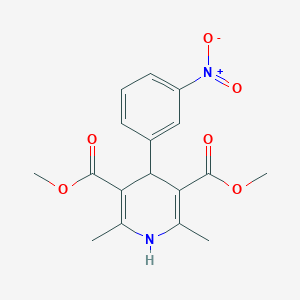
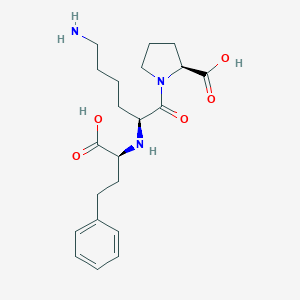

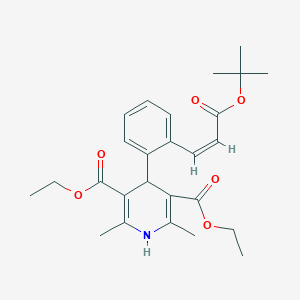
![{2-Butyl-5-chloro-3-[2'-(1-trityl-1H-tetrazol-5-yl)-biphenyl-4-ylmethyl]-3H-imidazol-4-yl}-methanol](/img/structure/B193138.png)
![2-[4-[[2-Butyl-4-chloro-5-(hydroxymethyl)imidazol-1-yl]methyl]phenyl]benzonitrile](/img/structure/B193149.png)
